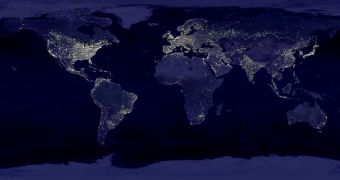According to the conclusions of a new scientific study, it would appear that analyzing the amount of lights coming from a certain area can be used as a predictor of how economically-developed that area actually is. Earth's lights can easily be seen by satellites in its orbit.
Broadway, the Las Vegas Strip or the Sunset Strip have become symbols associated with having fun for many people. Oftentimes, people walking lit-up streets at night do so for their own enjoyment, especially in touristic cities and regions.
But economists see something else when they look at maps depicting Earth's nighttime lights. They say that studying these datasets indicates which of the world's regions are the most financially prosperous.
As evidenced by the image attached to this article, most of Africa and the Middle East, in addition to portions of the South American continent, Australia, Antarctica and the Arctic, are dark. These regions are either uninhabited, or very, very poor, economists say.
The new investigation was carried out by Yale University Sterling professor of economics William Nordhaus, in collaboration with Xi Chen, a sociology researchers at the Quinnipiac University.
With the new study, the team basically demonstrated that it is possible to use Earth luminosity data collected from satellites to put together statistics that are relevant for nearly all areas of the world.
“We found it a very important possibility for synthesizing socioeconomic and geophysical data,” Nordhaus explains, in a paper called “Using luminosity data as a proxy for economic statistics.”
The work was published in the May 24 online issue of the esteemed journal Proceedings of the National Academy of Sciences (PNAS). Part of the funds required for the study came from the Division of Social and Economic Sciences (DSES), at the US National Science Foundation (NSF).
Other funds were secured from the US Department of Energy (DOE) and the Glaser Foundation.
The study also revealed an interesting limitation of luminosity datasets. The latter could only be used for practical applications on countries that had strong data collection programs. These nations include most of the developed world.
Other countries, such as, for example, most African nations, do not feature such programs. Their national statistics have very little relevance, and therefore cannot be correlated with luminosity data collected by satellites.
“What is really interesting is that the lights data are available at a very high resolution, close to 1 x 1 kilometers, and therefore have great promise for use as a proxy,” Nordhaus concludes.

 14 DAY TRIAL //
14 DAY TRIAL //